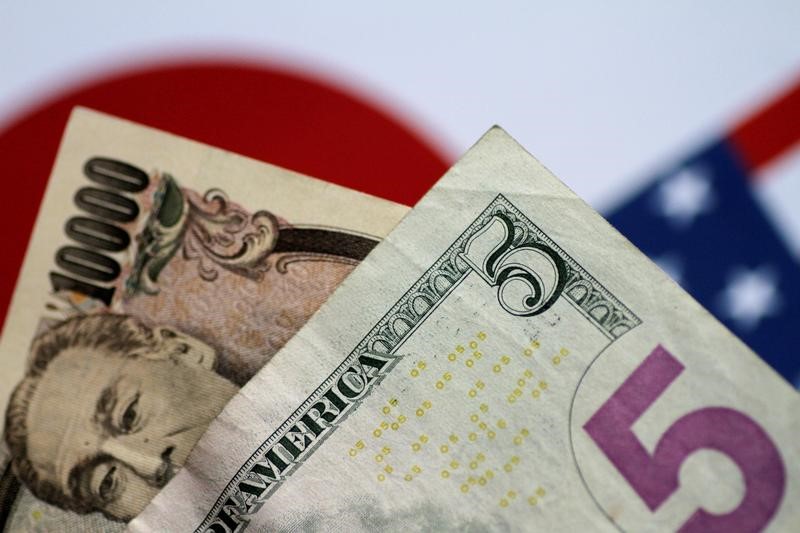Investing.com -- The potential impact of U.S. Federal Reserve rate cuts on the USD/JPY pair is a critical issue for investors and currency strategists, particularly as we approach a possible Fed pivot in 2024.
With divergent monetary policies between the Fed and the Bank of Japan (BoJ), market participants are divided on whether Fed rate cuts will lead to a weaker USD/JPY.
As per analysts at BofA, the relationship between Fed rate cuts and USD/JPY is more nuanced, with a variety of structural and macroeconomic factors playing a role.
Contrary to common market expectations, the relationship between Fed rate cuts and a weakening USD/JPY is not a given.
Historically, USD/JPY did not always decline during Fed easing cycles. The key exception was during the 2007–2008 Global Financial Crisis (GFC), when the unwinding of the yen carry trade caused significant yen appreciation.
Outside of the GFC, Fed rate cuts, such as those seen during the 1995–1996 and 2001–2003 cycles, did not lead to a major decline in USD/JPY.
This suggests that the context of the broader economy, particularly in the U.S., plays a crucial role in how USD/JPY reacts to Fed rate moves.
BofA analysts flag a shift in Japan's capital flows that dampens the likelihood of a sharp JPY appreciation in response to Fed rate cuts.
Japan's foreign asset holdings have shifted from foreign bonds to foreign direct investment and equities over the past decade.
Unlike bond investments, which are highly sensitive to interest rate differentials and the carry trade environment, FDI and equity investments are driven more by long-term growth prospects.
As a result, even if U.S. interest rates decline, Japanese investors are unlikely to repatriate funds en masse, limiting upward pressure on the yen.
Moreover, Japan's demographic challenges have contributed to persistent outward FDI, which has proven to be largely insensitive to U.S. interest rates or exchange rates.
This ongoing capital outflow is structurally bearish for the yen. Retail investors in Japan have also increased their foreign equity exposure through investment trusts (Toshins), and this trend is supported by the expanded Nippon Individual Savings Account (NISA) scheme, which encourages long-term investment rather than short-term speculative flows.
“Without a hard landing in the US economy, Fed rate cuts may not be fundamentally positive for JPY,” the analysts said.
The risk of a prolonged balance sheet recession in the U.S. remains limited, with the U.S. economy expected to achieve a soft landing.
In such a scenario, the USD/JPY is likely to remain elevated, especially as Fed rate cuts would likely be gradual and moderate, based on current forecasts.
The expectation of three 25-basis-point cuts by the end of 2024, rather than the 100+ basis points priced in by the market, further supports the view that USD/JPY could remain strong despite easing U.S. monetary policy.
Japanese life insurers (lifers), who have historically been major participants in foreign bond markets, are another key factor to consider.
While the high cost of hedging and a bearish yen outlook have led lifers to reduce their hedging ratios, this trend limits the potential for a JPY rally in the event of Fed rate cuts.
Furthermore, lifers have scaled back their exposure to foreign bonds, with public pension funds driving much of Japan's outward bond investment.
These pension funds are less likely to react to short-term market fluctuations, further reducing the likelihood of a yen appreciation.
While BofA remains constructive on USD/JPY, certain risks could alter the trajectory. A recession in the U.S. would likely lead to a more aggressive series of Fed rate cuts, potentially pushing USD/JPY down to 135 or lower.
However, this would require a significant deterioration in U.S. economic data, which is not the base case for most analysts. Conversely, if the U.S. economy reaccelerates and inflation pressures persist, USD/JPY could rise further, potentially retesting 160 in 2025.
The risk from BoJ policy changes is considered less significant. Although the BoJ is gradually normalizing its ultra-loose monetary policy, Japan's neutral rate remains well below that of the U.S., meaning Fed policy is likely to exert a greater influence on USD/JPY than BoJ moves.
Additionally, the Japanese economy is more sensitive to changes in the U.S. economy than the reverse, which reinforces the notion that Fed policy will be the dominant driver of USD/JPY.
